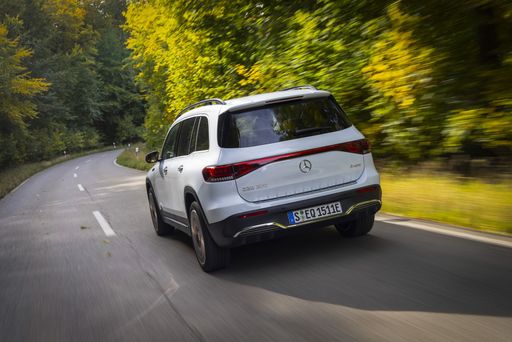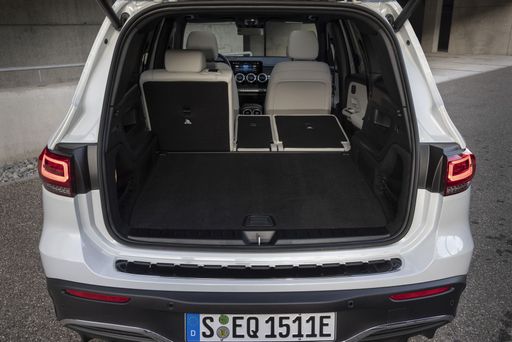Mercedes EQB VS Vauxhall Combo Cargo – Specs, Efficiency & Price Comparison
Which model is the better choice – the Mercedes EQB or the Vauxhall Combo Cargo? We compare performance (292 HP vs 136 HP), boot capacity (495 L vs ), efficiency (15.20 kWh vs 18.60 kWh5.40 L), and of course, the price (45900 £ vs 21200 £).
Find out now which car fits your needs better!
The Mercedes EQB (SUV) is powered by a Electric engine and comes with a Automatic transmission. In comparison, the Vauxhall Combo Cargo (Cargo Van) features a Diesel, Petrol or Electric engine and a Manuel or Automatic gearbox.
When it comes to boot capacity, the Mercedes EQB offers 495 L, while the Vauxhall Combo Cargo provides – depending on what matters most to you. If you’re looking for more power, you’ll need to decide whether the 292 HP of the Mercedes EQB or the 136 HP of the Vauxhall Combo Cargo suits your needs better.
There are also differences in efficiency: 15.20 kWh vs 18.60 kWh5.40 L. In terms of price, the Mercedes EQB starts at 45900 £, while the Vauxhall Combo Cargo is available from 21200 £.
Compare all the key specs now and find out which model fits your lifestyle best!
Mercedes EQB
The Mercedes-Benz EQB is an all-electric compact SUV that seamlessly blends practicality with modern luxury. Its sleek design and spacious interior make it an attractive option for families seeking both style and function. With advanced technology and impressive range capabilities, the EQB is a testament to Mercedes-Benz's commitment to sustainable mobility.
details @ group-media.mercedes-benz.com
@ group-media.mercedes-benz.com
 @ group-media.mercedes-benz.com
@ group-media.mercedes-benz.com
 @ group-media.mercedes-benz.com
@ group-media.mercedes-benz.com
 @ group-media.mercedes-benz.com
@ group-media.mercedes-benz.com
 @ group-media.mercedes-benz.com
@ group-media.mercedes-benz.com
Vauxhall Combo Cargo
The Opel Combo van is a versatile and practical choice for both businesses and families, offering ample space and comfort. Its efficient design provides ease of manoeuvrability in urban settings, while also delivering a smooth and reliable performance on longer journeys. The interior is thoughtfully equipped with modern features, ensuring a convenient and enjoyable driving experience.
details

|
|
|
|
|
Costs and Consumption |
|
|---|---|
|
Price
45900 - 58900 £
|
Price
21200 - 34500 £
|
|
Consumption L/100km
-
|
Consumption L/100km
5.4 - 6.7 L
|
|
Consumption kWh/100km
15.2 - 17.3 kWh
|
Consumption kWh/100km
18.6 - 19.2 kWh
|
|
Electric Range
445 - 533 km
|
Electric Range
326 - 336 km
|
|
Battery Capacity
66.5 - 70.5 kWh
|
Battery Capacity
-
|
|
co2
0 g/km
|
co2
0 - 151 g/km
|
|
Fuel tank capacity
-
|
Fuel tank capacity
50 - 60 L
|
Dimensions and Body |
|
|---|---|
|
Body Type
SUV
|
Body Type
Cargo Van
|
|
Seats
5
|
Seats
2 - 6
|
|
Doors
5
|
Doors
4 - 5
|
|
Curb weight
2105 - 2170 kg
|
Curb weight
1404 - 1888 kg
|
|
Trunk capacity
495 L
|
Trunk capacity
-
|
|
Length
4684 mm
|
Length
4401 - 4753 mm
|
|
Width
1834 mm
|
Width
1848 mm
|
|
Height
1654 - 1689 mm
|
Height
1820 - 1825 mm
|
|
Payload
435 kg
|
Payload
536 - 916 kg
|
Engine and Performance |
|
|---|---|
|
Engine Type
Electric
|
Engine Type
Diesel, Petrol, Electric
|
|
Transmission
Automatic
|
Transmission
Manuel, Automatic
|
|
Transmission Detail
Reduction Gearbox
|
Transmission Detail
Manual Gearbox, Automatic Gearbox, Reduction Gearbox
|
|
Drive Type
Front-Wheel Drive, All-Wheel Drive
|
Drive Type
Front-Wheel Drive
|
|
Power HP
190 - 292 HP
|
Power HP
102 - 136 HP
|
|
Acceleration 0-100km/h
6.2 - 8.9 s
|
Acceleration 0-100km/h
-
|
|
Max Speed
160 km/h
|
Max Speed
132 - 184 km/h
|
|
Torque
385 - 520 Nm
|
Torque
205 - 300 Nm
|
|
Number of Cylinders
-
|
Number of Cylinders
3 - 4
|
|
Power kW
140 - 215 kW
|
Power kW
75 - 100 kW
|
|
Engine capacity
-
|
Engine capacity
1199 - 1499 cm3
|
General |
|
|---|---|
|
Model Year
2024 - 2025
|
Model Year
2024
|
|
CO2 Efficiency Class
A
|
CO2 Efficiency Class
E, A
|
|
Brand
Mercedes-Benz
|
Brand
Vauxhall
|
Mercedes EQB
Introducing the Mercedes-Benz EQB: A New Era in Electric SUVs
The Mercedes-Benz EQB is a striking testament to the innovative prowess of Mercedes-Benz in the realm of electric vehicles. As an SUV designed for the future, the EQB merges luxury with sustainability, offering a remarkable driving experience complemented by state-of-the-art technology.
Powerful Performance and Efficient Design
Under the bonnet, the EQB is powered by an electric motor that produces between 190 to 292 PS, translating to 140 to 215 kW. This powerful engine allows the EQB to achieve a 0-100 km/h acceleration in just 6.2 to 8.9 seconds, rivaling many other vehicles in its class.
Fuel efficiency remains at the forefront of the EQB's design, with a consumption rate ranging from 15.2 to 17.3 kWh per 100 km. This efficiency ensures the vehicle maintains an impressive electric range between 445 to 533 km per charge, giving drivers the confidence to embark on longer journeys without constant recharging.
Cutting-Edge Technological Innovations
The EQB is packed with innovations that make driving an intuitive and seamless experience. The vehicle boasts a state-of-the-art emissions rating of zero CO2 per km, proudly placing it in the A class of CO2 efficiency. The integrated automatic transmission, specifically the Reduktionsgetriebe, offers smooth transitions and enhances overall driving comfort.
Roomy Interior and Premium Features
Step inside the EQB to find a spacious and luxurious interior, capable of accommodating five passengers comfortably. With a luggage capacity of 495 litres, this SUV caters to both adventure and everyday needs. The EQB comes available in several exquisite lines, including AMG Line Advanced and Electric Art Advanced Plus, ensuring there's a version to match every style preference.
Safety and Reliability
Safety has always been a priority for Mercedes-Benz, and the EQB continues this legacy. With an all-wheel-drive option on certain models, enhanced traction and stability are provided across a variety of driving conditions. Furthermore, the EQB's substantial weight range from 2105 to 2170 kg adds to its robust and stable feel on the road.
Pricing and Ownership Costs
The price of the EQB starts at €53,514, and the top-end models can go up to €68,734. Mercedes-Benz offers several financing options to suit various budgets, with running costs calculated at approximately 47.4 to 55.9 cents per kilometre, making it an economically viable choice for the environmentally conscious driver.
The Mercedes-Benz EQB is more than just a vehicle; it represents a shift towards a more sustainable future, without compromising on luxury or performance. Whether you're navigating city streets or venturing into the countryside, the EQB is engineered to deliver an exceptional driving experience every time.
Vauxhall Combo Cargo
Discovering the Opel Combo: A Compact Van with Big Capabilities
The Opel Combo is a standout in the realm of compact vans, offering a blend of practicality, efficiency, and advanced technology. Whether you are a small business owner in need of a reliable transport solution or an eco-conscious driver looking for a green alternative, the Opel Combo has something to offer. Let's delve into the technical details and innovations that make this van a noteworthy contender in its class.
Engine Options: Flexibility Meets Efficiency
The Opel Combo boasts a wide range of engine options to cater to various driving needs. Available in both diesel and petrol, as well as electric versions, the Combo offers a versatile selection of powertrains. With engine power ranging from 102 PS to an impressive 136 PS, the Combo ensures that you have enough oomphto get the job done.
The diesel variants present efficient fuel consumption statistics, with figures between 5.4 to 5.9 L/100 km, ensuring fewer stops at the fuel station. Meanwhile, the electric models offer an attractive alternative with a range of 326 to 336 km on a single charge, emphasizing Opel's commitment to sustainable mobility.
Innovative Technology: A Step Forward
Innovation in the Opel Combo is not just limited to its engines. It incorporates state-of-the-art features designed to enhance the driving experience. Automatic transmission options provide smooth gear transitions, reducing driver effort and fatigue, especially in urban settings. A key technological highlight is the inclusion of advanced driver assistance systems which enhance safety and ease of use.
The Combo's infotainment system is equipped with all the modern connectivity options, making it easy for users to stay connected on the go. With intuitive controls and an ergonomic layout, the system enhances the overall driving experience by keeping essential functions accessible at all times.
Design and Practicality: Structured for Success
Opel has masterfully balanced form and function in the Combo's design. With a compact exterior measuring between 4401 to 4753 mm in length, the Combo is perfect for navigating urban environments without sacrificing cargo space. The van offers a generous payload capacity of up to 916 kg, demonstrating its ability to handle demanding logistical tasks.
Inside, the Combo provides comfort and practicality with seating configurations ranging from 2 to 6 seats. This flexibility makes it ideal for both goods transport and ferrying staff. With a maximum speed of up to 184 km/h, the Combo ensures timely deliveries while maintaining Opel's standard for safety and efficiency.
Environmental Considerations: Efficient and Responsible
The Opel Combo manages to balance power and environmental responsibility efficiently. CO2 emissions range from 0 for electric variants to a moderate 155 g/km for certain diesel configurations. These figures demonstrate Opel's dedication to reducing the environmental footprint of its vehicles.
Moreover, the Combo Electric models, with energy consumption as low as 18.6 kWh/100 km, prove that Opel is committed to offering cleaner, alternative fuel vehicles that meet modern environmental standards.
Conclusion: A Compact Van That Packs a Punch
The Opel Combo emerges as a versatile and innovative choice in the compact van segment, blending efficiency, technology, and practicality seamlessly. For those searching for a reliable partner in business or an eco-friendly transport solution, the Combo stands out as a compelling choice. With a price range that accommodates various budgets, the Opel Combo deserves serious consideration from anyone in need of a robust yet refined transport solution.
The prices and data displayed are estimates based on German list prices and may vary by country. This information is not legally binding.
